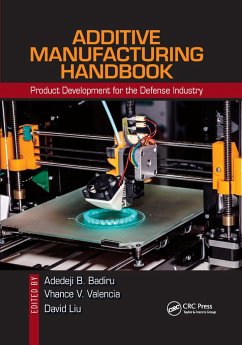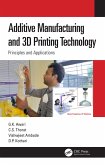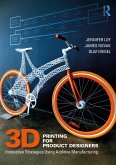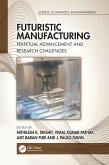Additive Manufacturing Handbook
Product Development for the Defense Industry
Herausgeber: Badiru, Adedeji B.; Liu, David; Valencia, Vhance V.
Additive Manufacturing Handbook
Product Development for the Defense Industry
Herausgeber: Badiru, Adedeji B.; Liu, David; Valencia, Vhance V.
- Broschiertes Buch
- Merkliste
- Auf die Merkliste
- Bewerten Bewerten
- Teilen
- Produkt teilen
- Produkterinnerung
- Produkterinnerung
Additive Manufacturing Handbook focuses on product design for the defense industry, which affects virtually every other industry. Thus, the handbook provides a wide range of benefits to all segments of business, industry, and government. Manufacturing has undergone a major advancement and technology shift in recent years.
Andere Kunden interessierten sich auch für
![Post-Processing Techniques for Metal-Based Additive Manufacturing Post-Processing Techniques for Metal-Based Additive Manufacturing]() Hao WangPost-Processing Techniques for Metal-Based Additive Manufacturing132,99 €
Hao WangPost-Processing Techniques for Metal-Based Additive Manufacturing132,99 €![Additive Manufacturing Additive Manufacturing]() Manu SrivastavaAdditive Manufacturing49,99 €
Manu SrivastavaAdditive Manufacturing49,99 €![Additive Manufacturing with Medical Applications Additive Manufacturing with Medical Applications]() Additive Manufacturing with Medical Applications186,99 €
Additive Manufacturing with Medical Applications186,99 €![Additive Manufacturing and 3D Printing Technology Additive Manufacturing and 3D Printing Technology]() G. K. Awari (Nagpur Gov. Polytechnic)Additive Manufacturing and 3D Printing Technology156,99 €
G. K. Awari (Nagpur Gov. Polytechnic)Additive Manufacturing and 3D Printing Technology156,99 €![3D Printing for Product Designers 3D Printing for Product Designers]() Jennifer Loy3D Printing for Product Designers52,99 €
Jennifer Loy3D Printing for Product Designers52,99 €![Advanced Manufacturing Methods Advanced Manufacturing Methods]() Advanced Manufacturing Methods185,99 €
Advanced Manufacturing Methods185,99 €![Futuristic Manufacturing Futuristic Manufacturing]() Futuristic Manufacturing123,99 €
Futuristic Manufacturing123,99 €-
-
-
Additive Manufacturing Handbook focuses on product design for the defense industry, which affects virtually every other industry. Thus, the handbook provides a wide range of benefits to all segments of business, industry, and government. Manufacturing has undergone a major advancement and technology shift in recent years.
Hinweis: Dieser Artikel kann nur an eine deutsche Lieferadresse ausgeliefert werden.
Hinweis: Dieser Artikel kann nur an eine deutsche Lieferadresse ausgeliefert werden.
Produktdetails
- Produktdetails
- Systems Innovation Book Series
- Verlag: Taylor & Francis Ltd
- Seitenzahl: 948
- Erscheinungstermin: 30. September 2020
- Englisch
- Abmessung: 254mm x 178mm x 50mm
- Gewicht: 1700g
- ISBN-13: 9780367871215
- ISBN-10: 0367871211
- Artikelnr.: 59991361
- Herstellerkennzeichnung
- Libri GmbH
- Europaallee 1
- 36244 Bad Hersfeld
- gpsr@libri.de
- Systems Innovation Book Series
- Verlag: Taylor & Francis Ltd
- Seitenzahl: 948
- Erscheinungstermin: 30. September 2020
- Englisch
- Abmessung: 254mm x 178mm x 50mm
- Gewicht: 1700g
- ISBN-13: 9780367871215
- ISBN-10: 0367871211
- Artikelnr.: 59991361
- Herstellerkennzeichnung
- Libri GmbH
- Europaallee 1
- 36244 Bad Hersfeld
- gpsr@libri.de
Dr. Adedeji B. Badiru is a professor of systems engineering at the Air Force Institute of Technology (AFIT), Wright-Patterson Air Force Base, Ohio. He is a registered professional engineer (PE). He is a fellow of the Institute of Industrial & Systems Engineers and a fellow of the Nigerian Academy of Engineering. He is also a certified project management professional (PMP). He is PhD in industrial engineering from the University of Central Florida, Orlando, Florida. Dr. Badiru is the author of several books and technical journal articles. His areas of interest include manufacturing systems, technology transfer, project management, mathematical modeling and simulation, economic analysis, learning curve analysis, quality engineering, and productivity improvement. Dr. Vhance V. Valencia is an assistant professor in the Systems Engineering and Management Department, Air Force Institute of Technology (AFIT), Wright-Patterson Air Force Base, Ohio. He earned his PhD in systems engineering (2013) from AFIT; an MS in engineering management (2007) from AFIT; and a BS in mechanical engineering (2001) from San Diego State University, San Diego, California. Dr. Valencia is also a military officer and has held various engineering positions within the United States Air Force including facility construction and infrastructure program management, project management, and various staff and other leadership positions. A prolific writer, he has coauthored one book and written numerous journal articles and conference papers. His research interests include engineering applications for additive manufacturing, management of infrastructure assets and systems, systems engineering, and systems modeling and analysis. Dr. Valencia is a registered professional engineer and a member of the Society of American Military Engineers. Dr. David Liu is an aerospace engineer at the Weapons Directorate, Air Force Lifecycle Management Center (AFLCMC) on
Acknowledgments
Dedication
Preface
Section I: Introductory Section
Chapter 01: From Traditional Manufacturing to Additive Manufacturing
Chapter 2: A Novice's Guide to 3D Printing Making the Process Less Magical and More Understandable
Chapter 3: Comprehensive Project Management of High End Additive Manufacturing Equipment
Chapter 4: 3D-Printing Impacts on Systems Engineering In Defense Industry
Chapter 5: 3D Printing Design Using Systems Engineering
Chapter 6: Evaluation of Existing Modeling Software
Chapter 7: Additive Manufacturing Research and Development Needs
Chapter 8: Operational Aspects and Regulatory Gaps in Additive Manufacturing
Chapter 9: Additive Manufacturing and Its Implications for Military Ethics
Chapter 10: Additive manufacturing technologies: state of the art and trends
Chapter 11: A new global approach to design for additive manufacturing
Chapter 12: A new methodological framework for design for additive manufacturing
Section II: Technical Section
Chapter 13: Development and Implementation of Metals Additive Manufacturing
Chapter 14: Selective Laser Melting (SLM) of Ni-based Superalloys - A Mechanics of Materials Review
Chapter 15: A Review on Powder Bed Fusion Technology of Metal Additive Manufacturing
Chapter 16: Additive Manufacturing of Titanium Alloys
Chapter 17: Ultrasonic Additive Manufacturing
Chapter 18: Printing Components for Reciprocating Engine Applications
Chapter 19: Developing Practical Additive Manufacturing Design Methods
Chapter 20: Optical Diagnostics for Real-Time Monitoring and Feedback Control of Metal Additive Manufacturing Processes
Chapter 21: 3D Printed Structures for Nano-Scale Research
Chapter 22: Additive Manufacturing at the Micron Scale
Chapter 23: Computer Modeling of Sol-Gel Thin Film Deposition Using Finite Element Analysis
Chapter 24: Additive Manufacturing Technology Review: From Prototyping To Production
Chapter 25: Mechanical Property Optimization of Fused Deposition Modeled P
Dedication
Preface
Section I: Introductory Section
Chapter 01: From Traditional Manufacturing to Additive Manufacturing
Chapter 2: A Novice's Guide to 3D Printing Making the Process Less Magical and More Understandable
Chapter 3: Comprehensive Project Management of High End Additive Manufacturing Equipment
Chapter 4: 3D-Printing Impacts on Systems Engineering In Defense Industry
Chapter 5: 3D Printing Design Using Systems Engineering
Chapter 6: Evaluation of Existing Modeling Software
Chapter 7: Additive Manufacturing Research and Development Needs
Chapter 8: Operational Aspects and Regulatory Gaps in Additive Manufacturing
Chapter 9: Additive Manufacturing and Its Implications for Military Ethics
Chapter 10: Additive manufacturing technologies: state of the art and trends
Chapter 11: A new global approach to design for additive manufacturing
Chapter 12: A new methodological framework for design for additive manufacturing
Section II: Technical Section
Chapter 13: Development and Implementation of Metals Additive Manufacturing
Chapter 14: Selective Laser Melting (SLM) of Ni-based Superalloys - A Mechanics of Materials Review
Chapter 15: A Review on Powder Bed Fusion Technology of Metal Additive Manufacturing
Chapter 16: Additive Manufacturing of Titanium Alloys
Chapter 17: Ultrasonic Additive Manufacturing
Chapter 18: Printing Components for Reciprocating Engine Applications
Chapter 19: Developing Practical Additive Manufacturing Design Methods
Chapter 20: Optical Diagnostics for Real-Time Monitoring and Feedback Control of Metal Additive Manufacturing Processes
Chapter 21: 3D Printed Structures for Nano-Scale Research
Chapter 22: Additive Manufacturing at the Micron Scale
Chapter 23: Computer Modeling of Sol-Gel Thin Film Deposition Using Finite Element Analysis
Chapter 24: Additive Manufacturing Technology Review: From Prototyping To Production
Chapter 25: Mechanical Property Optimization of Fused Deposition Modeled P
Acknowledgments
Dedication
Preface
Section I: Introductory Section
Chapter 01: From Traditional Manufacturing to Additive Manufacturing
Chapter 2: A Novice's Guide to 3D Printing Making the Process Less Magical and More Understandable
Chapter 3: Comprehensive Project Management of High End Additive Manufacturing Equipment
Chapter 4: 3D-Printing Impacts on Systems Engineering In Defense Industry
Chapter 5: 3D Printing Design Using Systems Engineering
Chapter 6: Evaluation of Existing Modeling Software
Chapter 7: Additive Manufacturing Research and Development Needs
Chapter 8: Operational Aspects and Regulatory Gaps in Additive Manufacturing
Chapter 9: Additive Manufacturing and Its Implications for Military Ethics
Chapter 10: Additive manufacturing technologies: state of the art and trends
Chapter 11: A new global approach to design for additive manufacturing
Chapter 12: A new methodological framework for design for additive manufacturing
Section II: Technical Section
Chapter 13: Development and Implementation of Metals Additive Manufacturing
Chapter 14: Selective Laser Melting (SLM) of Ni-based Superalloys - A Mechanics of Materials Review
Chapter 15: A Review on Powder Bed Fusion Technology of Metal Additive Manufacturing
Chapter 16: Additive Manufacturing of Titanium Alloys
Chapter 17: Ultrasonic Additive Manufacturing
Chapter 18: Printing Components for Reciprocating Engine Applications
Chapter 19: Developing Practical Additive Manufacturing Design Methods
Chapter 20: Optical Diagnostics for Real-Time Monitoring and Feedback Control of Metal Additive Manufacturing Processes
Chapter 21: 3D Printed Structures for Nano-Scale Research
Chapter 22: Additive Manufacturing at the Micron Scale
Chapter 23: Computer Modeling of Sol-Gel Thin Film Deposition Using Finite Element Analysis
Chapter 24: Additive Manufacturing Technology Review: From Prototyping To Production
Chapter 25: Mechanical Property Optimization of Fused Deposition Modeled P
Dedication
Preface
Section I: Introductory Section
Chapter 01: From Traditional Manufacturing to Additive Manufacturing
Chapter 2: A Novice's Guide to 3D Printing Making the Process Less Magical and More Understandable
Chapter 3: Comprehensive Project Management of High End Additive Manufacturing Equipment
Chapter 4: 3D-Printing Impacts on Systems Engineering In Defense Industry
Chapter 5: 3D Printing Design Using Systems Engineering
Chapter 6: Evaluation of Existing Modeling Software
Chapter 7: Additive Manufacturing Research and Development Needs
Chapter 8: Operational Aspects and Regulatory Gaps in Additive Manufacturing
Chapter 9: Additive Manufacturing and Its Implications for Military Ethics
Chapter 10: Additive manufacturing technologies: state of the art and trends
Chapter 11: A new global approach to design for additive manufacturing
Chapter 12: A new methodological framework for design for additive manufacturing
Section II: Technical Section
Chapter 13: Development and Implementation of Metals Additive Manufacturing
Chapter 14: Selective Laser Melting (SLM) of Ni-based Superalloys - A Mechanics of Materials Review
Chapter 15: A Review on Powder Bed Fusion Technology of Metal Additive Manufacturing
Chapter 16: Additive Manufacturing of Titanium Alloys
Chapter 17: Ultrasonic Additive Manufacturing
Chapter 18: Printing Components for Reciprocating Engine Applications
Chapter 19: Developing Practical Additive Manufacturing Design Methods
Chapter 20: Optical Diagnostics for Real-Time Monitoring and Feedback Control of Metal Additive Manufacturing Processes
Chapter 21: 3D Printed Structures for Nano-Scale Research
Chapter 22: Additive Manufacturing at the Micron Scale
Chapter 23: Computer Modeling of Sol-Gel Thin Film Deposition Using Finite Element Analysis
Chapter 24: Additive Manufacturing Technology Review: From Prototyping To Production
Chapter 25: Mechanical Property Optimization of Fused Deposition Modeled P









